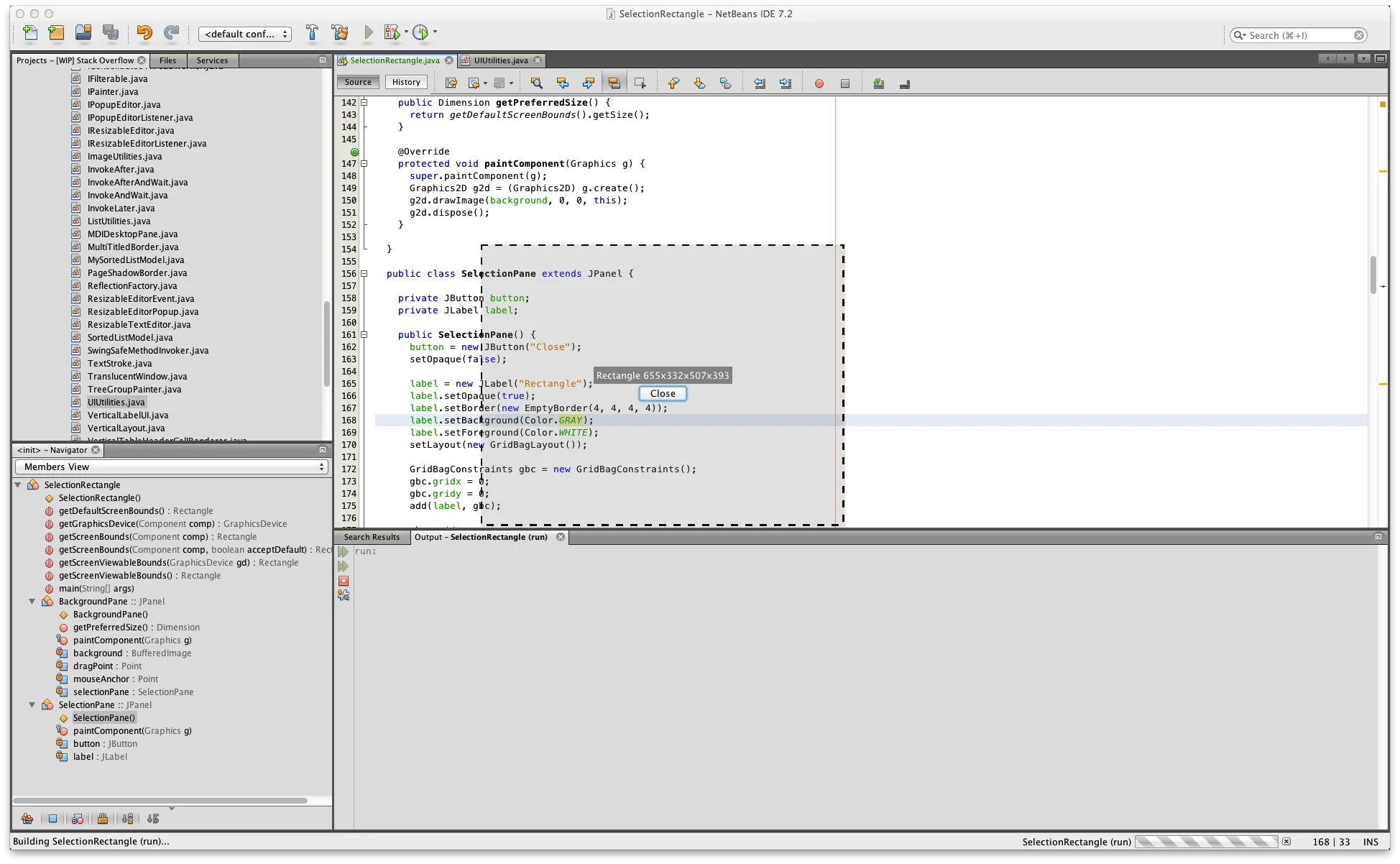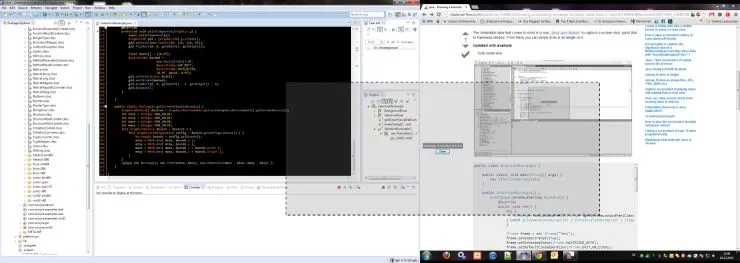
我如何在屏幕上绘制半透明矩形?这不能是一个JFrame,因为JFrames有通常在右上角的关闭、最小化、最大化选项。
如果确实是一个Swing组件,那么它是如何在空气中绘制的?而没有插入任何JFrame呢?
请告诉我它是什么以及我应该如何实现它...

我如何在屏幕上绘制半透明矩形?这不能是一个JFrame,因为JFrames有通常在右上角的关闭、最小化、最大化选项。
如果确实是一个Swing组件,那么它是如何在空气中绘制的?而没有插入任何JFrame呢?
请告诉我它是什么以及我应该如何实现它...
首先想到的方法是使用java.awt.Robot来截屏,然后将其绘制到无边框窗口中。从那里你可以简单地在上面画一个矩形。
更新示例:
... 花了一些时间 ...

public class SelectionRectangle {
public static void main(String[] args) {
new SelectionRectangle();
}
public SelectionRectangle() {
EventQueue.invokeLater(new Runnable() {
@Override
public void run() {
try {
UIManager.setLookAndFeel(UIManager.getSystemLookAndFeelClassName());
} catch (ClassNotFoundException | InstantiationException | IllegalAccessException | UnsupportedLookAndFeelException ex) {
}
JFrame frame = new JFrame("Test");
frame.setUndecorated(true);
frame.setExtendedState(JFrame.MAXIMIZED_BOTH);
frame.setDefaultCloseOperation(JFrame.EXIT_ON_CLOSE);
frame.setLayout(new BorderLayout());
frame.add(new BackgroundPane());
frame.pack();
frame.setLocationRelativeTo(null);
frame.setVisible(true);
}
});
}
public class BackgroundPane extends JPanel {
private BufferedImage background;
private Point mouseAnchor;
private Point dragPoint;
private SelectionPane selectionPane;
public BackgroundPane() {
selectionPane = new SelectionPane();
try {
Robot bot = new Robot();
background = bot.createScreenCapture(getScreenViewableBounds());
} catch (AWTException ex) {
Logger.getLogger(SelectionRectangle.class.getName()).log(Level.SEVERE, null, ex);
}
selectionPane = new SelectionPane();
setLayout(null);
add(selectionPane);
MouseAdapter adapter = new MouseAdapter() {
@Override
public void mousePressed(MouseEvent e) {
mouseAnchor = e.getPoint();
dragPoint = null;
selectionPane.setLocation(mouseAnchor);
selectionPane.setSize(0, 0);
}
@Override
public void mouseDragged(MouseEvent e) {
dragPoint = e.getPoint();
int width = dragPoint.x - mouseAnchor.x;
int height = dragPoint.y - mouseAnchor.y;
int x = mouseAnchor.x;
int y = mouseAnchor.y;
if (width < 0) {
x = dragPoint.x;
width *= -1;
}
if (height < 0) {
y = dragPoint.y;
height *= -1;
}
selectionPane.setBounds(x, y, width, height);
selectionPane.revalidate();
repaint();
}
};
addMouseListener(adapter);
addMouseMotionListener(adapter);
}
@Override
protected void paintComponent(Graphics g) {
super.paintComponent(g);
Graphics2D g2d = (Graphics2D) g.create();
g2d.drawImage(background, 0, 0, this);
g2d.dispose();
}
}
public class SelectionPane extends JPanel {
private JButton button;
private JLabel label;
public SelectionPane() {
button = new JButton("Close");
setOpaque(false);
label = new JLabel("Rectangle");
label.setOpaque(true);
label.setBorder(new EmptyBorder(4, 4, 4, 4));
label.setBackground(Color.GRAY);
label.setForeground(Color.WHITE);
setLayout(new GridBagLayout());
GridBagConstraints gbc = new GridBagConstraints();
gbc.gridx = 0;
gbc.gridy = 0;
add(label, gbc);
gbc.gridy++;
add(button, gbc);
button.addActionListener(new ActionListener() {
@Override
public void actionPerformed(ActionEvent e) {
SwingUtilities.getWindowAncestor(SelectionPane.this).dispose();
}
});
addComponentListener(new ComponentAdapter() {
@Override
public void componentResized(ComponentEvent e) {
label.setText("Rectangle " + getX() + "x" + getY() + "x" + getWidth() + "x" + getHeight());
}
});
}
@Override
protected void paintComponent(Graphics g) {
super.paintComponent(g);
Graphics2D g2d = (Graphics2D) g.create();
g2d.setColor(new Color(128, 128, 128, 64));
g2d.fillRect(0, 0, getWidth(), getHeight());
float dash1[] = {10.0f};
BasicStroke dashed =
new BasicStroke(3.0f,
BasicStroke.CAP_BUTT,
BasicStroke.JOIN_MITER,
10.0f, dash1, 0.0f);
g2d.setColor(Color.BLACK);
g2d.setStroke(dashed);
g2d.drawRect(0, 0, getWidth() - 3, getHeight() - 3);
g2d.dispose();
}
}
public static Rectangle getScreenViewableBounds() {
GraphicsEnvironment ge = GraphicsEnvironment.getLocalGraphicsEnvironment();
GraphicsDevice gd = ge.getDefaultScreenDevice();
return getScreenViewableBounds(gd);
}
public static Rectangle getScreenViewableBounds(GraphicsDevice gd) {
Rectangle bounds = new Rectangle(0, 0, 0, 0);
if (gd != null) {
GraphicsConfiguration gc = gd.getDefaultConfiguration();
bounds = gc.getBounds();
Insets insets = Toolkit.getDefaultToolkit().getScreenInsets(gc);
bounds.x += insets.left;
bounds.y += insets.top;
bounds.width -= (insets.left + insets.right);
bounds.height -= (insets.top + insets.bottom);
}
return bounds;
}
}
使用 SnipIt 示例进行更新
有些人建议使用一个透明的窗口覆盖在屏幕顶部,但实际上这是行不通的,因为透明窗口实际上不会响应鼠标点击,除非它们有一些东西可以被绘制在它们上面,从而允许捕获鼠标事件。
另外一种方法是使用类似 SnipIt 的工具。
也有人建议使用窗口作为选择机制,这是一个有效的答案,但我个人认为这不是一个合适的解决方案,因为你希望用户只需单击并拖动选择矩形(在我看来)。

public class SnipIt {
public static void main(String[] args) {
new SnipIt();
}
public SnipIt() {
EventQueue.invokeLater(new Runnable() {
@Override
public void run() {
try {
UIManager.setLookAndFeel(UIManager.getSystemLookAndFeelClassName());
} catch (ClassNotFoundException | InstantiationException | IllegalAccessException | UnsupportedLookAndFeelException ex) {
}
JFrame frame = new JFrame();
frame.setUndecorated(true);
// This works differently under Java 6
frame.setBackground(new Color(0, 0, 0, 0));
frame.setDefaultCloseOperation(JFrame.EXIT_ON_CLOSE);
frame.setLayout(new BorderLayout());
frame.add(new SnipItPane());
frame.setBounds(getVirtualBounds());
frame.setVisible(true);
}
});
}
public class SnipItPane extends JPanel {
private Point mouseAnchor;
private Point dragPoint;
private SelectionPane selectionPane;
public SnipItPane() {
setOpaque(false);
setLayout(null);
selectionPane = new SelectionPane();
add(selectionPane);
MouseAdapter adapter = new MouseAdapter() {
@Override
public void mousePressed(MouseEvent e) {
mouseAnchor = e.getPoint();
dragPoint = null;
selectionPane.setLocation(mouseAnchor);
selectionPane.setSize(0, 0);
}
@Override
public void mouseDragged(MouseEvent e) {
dragPoint = e.getPoint();
int width = dragPoint.x - mouseAnchor.x;
int height = dragPoint.y - mouseAnchor.y;
int x = mouseAnchor.x;
int y = mouseAnchor.y;
if (width < 0) {
x = dragPoint.x;
width *= -1;
}
if (height < 0) {
y = dragPoint.y;
height *= -1;
}
selectionPane.setBounds(x, y, width, height);
selectionPane.revalidate();
repaint();
}
};
addMouseListener(adapter);
addMouseMotionListener(adapter);
}
@Override
protected void paintComponent(Graphics g) {
super.paintComponent(g);
Graphics2D g2d = (Graphics2D) g.create();
Rectangle bounds = new Rectangle(0, 0, getWidth(), getHeight());
Area area = new Area(bounds);
area.subtract(new Area(selectionPane.getBounds()));
g2d.setColor(new Color(192, 192, 192, 64));
g2d.fill(area);
}
}
public class SelectionPane extends JPanel {
private JButton button;
private JLabel label;
public SelectionPane() {
button = new JButton("Close");
setOpaque(false);
label = new JLabel("Rectangle");
label.setOpaque(true);
label.setBorder(new EmptyBorder(4, 4, 4, 4));
label.setBackground(Color.GRAY);
label.setForeground(Color.WHITE);
setLayout(new GridBagLayout());
GridBagConstraints gbc = new GridBagConstraints();
gbc.gridx = 0;
gbc.gridy = 0;
add(label, gbc);
gbc.gridy++;
add(button, gbc);
button.addActionListener(new ActionListener() {
@Override
public void actionPerformed(ActionEvent e) {
SwingUtilities.getWindowAncestor(SelectionPane.this).dispose();
}
});
addComponentListener(new ComponentAdapter() {
@Override
public void componentResized(ComponentEvent e) {
label.setText("Rectangle " + getX() + "x" + getY() + "x" + getWidth() + "x" + getHeight());
}
});
}
@Override
protected void paintComponent(Graphics g) {
super.paintComponent(g);
Graphics2D g2d = (Graphics2D) g.create();
// I've chosen NOT to fill this selection rectangle, so that
// it now appears as if you're "cutting" away the selection
// g2d.setColor(new Color(128, 128, 128, 64));
// g2d.fillRect(0, 0, getWidth(), getHeight());
float dash1[] = {10.0f};
BasicStroke dashed =
new BasicStroke(3.0f,
BasicStroke.CAP_BUTT,
BasicStroke.JOIN_MITER,
10.0f, dash1, 0.0f);
g2d.setColor(Color.BLACK);
g2d.setStroke(dashed);
g2d.drawRect(0, 0, getWidth() - 3, getHeight() - 3);
g2d.dispose();
}
}
public static Rectangle getVirtualBounds() {
Rectangle bounds = new Rectangle(0, 0, 0, 0);
GraphicsEnvironment ge = GraphicsEnvironment.getLocalGraphicsEnvironment();
GraphicsDevice lstGDs[] = ge.getScreenDevices();
for (GraphicsDevice gd : lstGDs) {
bounds.add(gd.getDefaultConfiguration().getBounds());
}
return bounds;
}
}
robot可以用来捕获屏幕。然后可以使用ImageIO将其写入磁盘,但问题是:那个神秘的矩形是什么? - An SO User将多显示器支持更新为@MadProgrammer的示例答案。
没有ExtendedState(JFrame.MAXIMIZED_BOTH)和pack()

public SelectionRectangle() {
EventQueue.invokeLater(new Runnable() {
@Override
public void run() {
try {
UIManager.setLookAndFeel(UIManager.getSystemLookAndFeelClassName());
} catch (ClassNotFoundException | InstantiationException | IllegalAccessException | UnsupportedLookAndFeelException ex) {
}
JFrame frame = new JFrame("Test");
frame.setUndecorated(true);
frame.setDefaultCloseOperation(JFrame.EXIT_ON_CLOSE);
frame.setLayout(new BorderLayout());
frame.add(new BackgroundPane());
frame.setResizable( false );
frame.setBounds( getScreenViewableBounds() );
frame.setVisible(true);
}
});
}
public static Rectangle getScreenViewableBounds() {
GraphicsDevice[] devices = GraphicsEnvironment.getLocalGraphicsEnvironment().getScreenDevices();
int minx = Integer.MAX_VALUE;
int miny = Integer.MAX_VALUE;
int maxx = Integer.MIN_VALUE;
int maxy = Integer.MIN_VALUE;
for( GraphicsDevice device : devices ) {
for( GraphicsConfiguration config : device.getConfigurations() ) {
Rectangle bounds = config.getBounds();
minx = Math.min( minx, bounds.x );
miny = Math.min( miny, bounds.y );
maxx = Math.max( maxx, bounds.x + bounds.width );
maxy = Math.max( maxy, bounds.y + bounds.height );
}
}
return new Rectangle( new Point(minx, miny), new Dimension(maxx - minx, maxy - miny) );
}
public class ScreenRectangle extends JFrame {
public ScreenRectangle() {
this.setUndecorated(true);
this.setBackground(new Color(0, 0, 0, 0.25F));
// opacity ranges 0.0-1.0 and is the fourth paramater
this.add(new DrawPanel());
}
private class DrawPanel extends JPanel {
@Override
public void paintComponent(Graphics g) {
super.paintComponent(g);
g.drawRect(0, 0, this.getWidth(), this.getHeight());
// any other drawing
}
}
}
框架可能还需要进行setOpaque处理,或者需要处理面板大小,但这是它的一般思路。
super.paintComponent ;) - MadProgrammerJFrame会自动处理吗? - An SO UserpaintComponent 是负责清空 Graphics 上下文的,如果你不这样做,那么就可能会出现之前绘制组件时的绘图残留问题。 - MadProgrammer